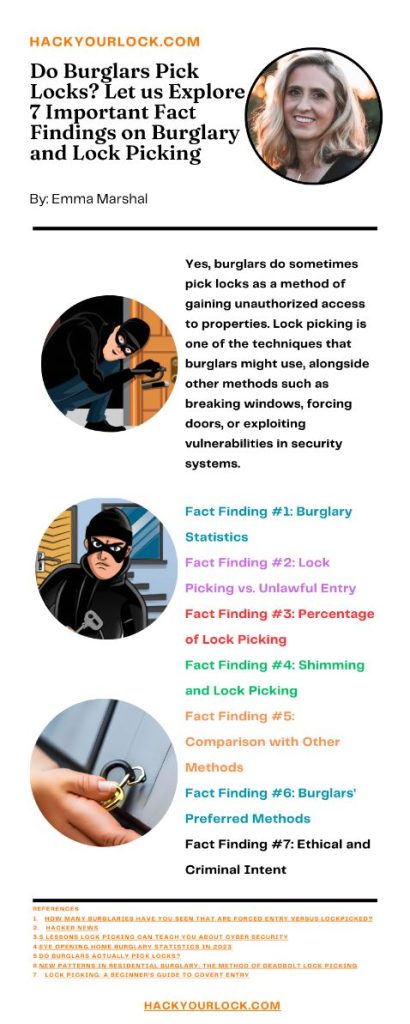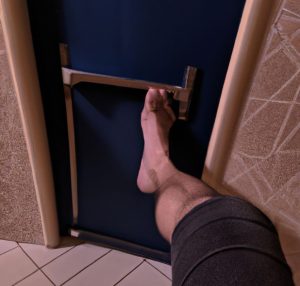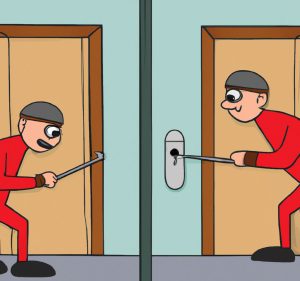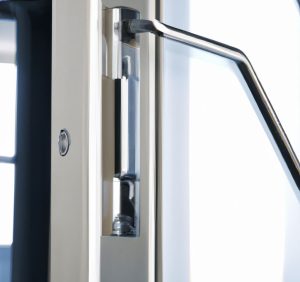Picture this: a dimly lit room, a shadowy figure bent over a lock, skillfully manipulating its components. It is a scene straight out of a suspenseful movie. But reality often imitates art, and the question lingers: do burglars really pick locks? In this article, we will dare to go beyond the silver screen to uncover the truth hanging behind the scenes.

From surprising statistics to the mechanics of lock picking, we will navigate through the facts to uncover whether lock picking truly serves as the key to a burglar’s entry. Our journey encompasses seven crucial fact findings that shed light on this perplexing art. So, fasten your seatbelt and join us as we explore the fascinating world of burglaries, locks, and the captivating question: do burglars pick locks?
Contents
- 1 Do Burglars Pick Locks?
- 2 Why do burglars not pick locks?
- 3 7 Facts and Findings on Burglary Statistics and Lock Picking
- 3.1 Fact Finding #1: Burglary Statistics
- 3.2 Fact Finding #2: Lock Picking vs. Unlawful Entry
- 3.3 Fact Finding #3: Percentage of Lock Picking
- 3.4 Fact Finding #4: Shimming and Lock Picking
- 3.5 Fact Finding #5: Comparison with Other Methods
- 3.6 Fact Finding #6: Burglars’ Preferred Methods
- 3.7 Fact Finding #7: Ethical and Criminal Intent
- 4 Conclusion
- 5 FAQ’s
- 6 Resources
Do Burglars Pick Locks?
Yes, burglars do sometimes pick locks as a method of gaining unauthorized access to properties. Lock picking is one of the techniques that burglars might use, alongside other methods such as breaking windows, forcing doors, or exploiting vulnerabilities in security systems.
However, it’s important to note that lock picking is just one of several approaches, and not all burglars rely on this method. The prevalence of lock picking in burglaries varies, and factors like the burglar’s skill level, target property, and the ease of other methods also play a role in their choice of entry.
Is Lock Picking Forced Entry in The U.S.?
No, lock picking is not considered forced entry in the U.S. Lock Picking: A Beginner’s Guide to Covert Entry tells that forced entry involves physically breaking or damaging a lock or barrier to gain access. In contrast, lock picking is the manipulation of a lock’s components without causing visible damage.
What Is The Most Common Way Burglars Break In?
The most common way burglars break in is by forcing entry through unlocked doors or windows. This method doesn’t involve sophisticated tools or techniques and takes advantage of easy opportunities for access.

The simple act of entering through unlocked points of entry accounts for a significant portion of burglaries. Burglars exploit negligence in securing doors, windows, or even garage entrances.

This method allows them to slip in quickly and discreetly, making it an attractive option for swift theft or unauthorized access. This also emphasizes a focused reply to the query, “Do burglars pick locks?” i.e. they prefer to do so in very few circumstances, and their priority is to cash the negligence of the property holder for entering and breaking the property. This debate has highlighted the importance of basic security practices like locking doors and windows to deter opportunistic burglars.
How Often Do Burglars Pick Locks, and What Percentage Of Burglars Pick Locks?
Burglars picking locks is relatively less common compared to other methods of entry. Statistics indicate that a small percentage of unlawful entries, around 4.1%, involve lock picking. Burglars often opt for quicker and more forceful methods, such as breaking windows or using tools, making lock picking a less frequent choice. Hence, most burglars do not prefer picking locks.
Why do burglars not pick locks?
Now that we know the answer to the query “Do burglars pick locks?” is “No, Mostly they do not,” we must find out the reasons behind this. Burglars often avoid picking locks due to several reasons. Lock picking requires a level of skill and time that may not be feasible during a burglary.
Additionally, other methods like breaking windows or using tools are quicker and less conspicuous. These methods also don’t leave behind evidence of tampering, which is a concern with lock picking.

Moreover, burglars might choose methods they’re more familiar with or have had success using before. Overall, the decision not to pick locks stems from a combination of efficiency, ease, and minimizing the risk of being caught.
Major reasons of why do burglars not pick locks, are as follows:
1. Unpredictability and Slow Process
Lock picking demands a certain level of expertise and time. It’s an unpredictable process with varying degrees of success, making it risky during time-sensitive break-ins. Other methods, like breaking windows or exploiting weak points, offer quicker entry and are less reliant on skill. So burglars do not pick locks while entering and breaking any property.
2. Predictable and Easy Alternatives
Easier options, such as exploiting unlocked doors or windows, are more predictable and less technically demanding than lock picking. Burglars often seek the path of least resistance, choosing methods they are more confident in executing swiftly.
3. Avoid Getting Caught
Lock picking could leave behind evidence of tampering, alerting occupants or authorities. Burglars prefer methods that minimize this risk, allowing them to remain unnoticed and escape without being caught red-handed.

Do burglars pick locks? While it is possible for burglars to pick locks, it is not their preferred method of entry. By opting for more efficient, less complicated methods, burglars prioritize speed, predictability, and reduction in their chances of detection, ultimately influencing their decision to bypass lock picking.
7 Facts and Findings on Burglary Statistics and Lock Picking
Fact Finding #1: Burglary Statistics
Do Burglars Actually Pick Locks? Recent burglary statistics provide valuable insights into various methods of entry. Among these, forcible entry accounts for approximately 60.5% of burglaries.
| Burglary Entry Method | Percentage of Burglaries |
|---|---|
| Forcible Entry | 60.5% |
| Unlawful Entry | 33.2% |
| Lock Picking | 6.3% |
Unlawful entry, which includes instances where you get entry without force, represents about 33.2%. Interestingly, attempts at lock picking contribute to around 6.3% of burglary incidents.
These percentages underscore the diverse tactics burglars employ to gain access, with lock picking playing a relatively smaller role in the overall landscape of entry methods.
Fact Finding #2: Lock Picking vs. Unlawful Entry
Lock picking is categorized under “unlawful entry” rather than “forcible entry.” This distinction is pivotal in the debate surrounding lock picking and breaking and entering.
While “forcible entry” implies the use of force or damage, “unlawful entry” encompasses non-forced methods, including lock picking. This categorization clarifies that lock picking doesn’t involve immediate force, but it still falls within the realm of unauthorized access.

This classification influences the discussion by highlighting the subtleties within unlawful entry methods. It demonstrates that lock picking, although non-destructive, is still considered unlawful due to its unauthorized nature.
This nuanced understanding aids in distinguishing between various entry methods, shedding light on the legal and ethical implications of each and enriching the broader conversation on security and intrusion. Lock picking doesn’t fall under “forcible entry,” ruling out 66.8% of burglaries as being related to lock picking.
Fact Finding #3: Percentage of Lock Picking
| Type of Unlawful Entry | Percentage of Unlawful Entries |
|---|---|
| Lock Picking (Including Shimming Window Latches and Sliding Door Locks) | 4.1% (2.2% when household members were present) |
Examining the National Crime Victimization Survey from the U.S. Department of Justice, it’s evident that only 4.1% (2.2% when household members were present) of the 33.2% unlawful entries involved picking a lock. This includes instances of shimming window latches and sliding door locks, which are also considered lock picking.
Fact Finding #4: Shimming and Lock Picking

Although shimming comes alongside lock picking, these methods could be separated. Many burglars claim that shimming sliding doors is a common technique, which might contribute to the higher percentage. However, due to a lack of data separation, the survey number of 4.1% is used. This raises the question: Do burglars pick locks as frequently as they employ shimming and similar techniques?”
Fact Finding #5: Comparison with Other Methods
Lockpicking’s prevalence in burglaries is relatively limited. While “Do burglars pick locks” as attempts contribute to around 6.3% of incidents, other methods are more common.
Tools like screwdrivers, crowbars, and hammers are frequently used, collectively accounting for 66.8% of forcible entries. This stark contrast underscores that burglars often favor more straightforward, forceful methods over the intricate process of **lock picking**.
The higher percentages attributed to these traditional tools emphasize their effectiveness in gaining access quickly, compared to the time and skill required for lock picking.
This data reinforces the notion that lockpicking, while intriguing, isn’t the primary method of choice for most burglars seeking entry.”
Fact Finding #6: Burglars’ Preferred Methods
Burglars often opt for non-lock-picking methods due to a combination of factors. Speed plays a significant role – methods like breaking windows or forcing doors allow swift entry, reducing the risk of detection. These techniques are also easier to execute, requiring minimal skill compared to lock picking’s intricate manipulation.
Familiarity with traditional methods further influences their choice. Many burglars are well-practiced in using tools like crowbars and screwdrivers, making them confident in their ability to gain access quickly.
These factors collectively drive burglars to prioritize methods that are efficient and familiar and minimize potential complications. While lock picking might offer an alternative approach, its complexities, and time requirements often render it a less appealing option for burglars seeking practical and effective methods of entry.
All the above facts clearly come up as an answer to the query asked by many people, i.e., do burglars pick locks? Yes, they do, but it is not among the preferred modes of gaining entry during the act of burglary.
Fact Finding #7: Ethical and Criminal Intent
The ethics of lock picking are entwined with the question of criminal intent. Lock picking is a skill that varies in application. Do burglars pick locks as a skill that can be used in various ways. No.
Security professionals and hobbyists use it for legitimate purposes, such as enhancing locks or educational endeavors. However, the same skill gets misused by individuals with malicious intent for criminal activities.

This diversity of motives creates an ethical grey area. While lock picking itself isn’t inherently criminal, its intent determines its ethical stance. Responsible use for educational, security, or professional purposes contrasts with malicious use for unauthorized access.

This ethical dichotomy underscores the need to consider the broader context and intentions, urging responsible practice that aligns with ethical boundaries.
Conclusion
In unraveling the query “Do Burglars Pick Locks?” we’ve uncovered essential insights. Our fact findings reveal that while lock picking can play a role in burglaries, it is not the prevailing method of entry. Statistics demonstrate that other techniques, often involving tools and force, hold a larger share of unauthorized access incidents.
In conclusion, our data sheds light on a reality where the prevalence of lock picking in burglaries is less prominent, even though the appeal of its movie mystique still exists. We navigate the complex terrain of lock picking’s junction with burglary by adopting a nuanced perspective, improving our knowledge of security dynamics in the process.
FAQ’s
Can burglars pick locks?
Yes, burglars can pick locks, but there are other prevalent methods they use for gaining unauthorized access.
When you pick a lock, do you break it?
When picking a lock skillfully, you do not break it; instead, you manipulate its components to unlock it without causing visible damage.
Is lock picking breaking and entering?
Lock picking itself is not inherently breaking and entering. However, its categorization as such depends on the context, legality, and intent behind its use.
Resources
- How many burglaries have you seen that are forced entry versus lockpicked?
- Hacker News
- 5 Lessons Lock Picking Can Teach You About Cyber Security
- Eye Opening Home Burglary Statistics In 2023
- Do Burglars Actually Pick Locks?
- New Patterns In Residential Burglary: The Method Of Deadbolt Lock Picking
- Lock Picking: A Beginner’s Guide to Covert Entry
